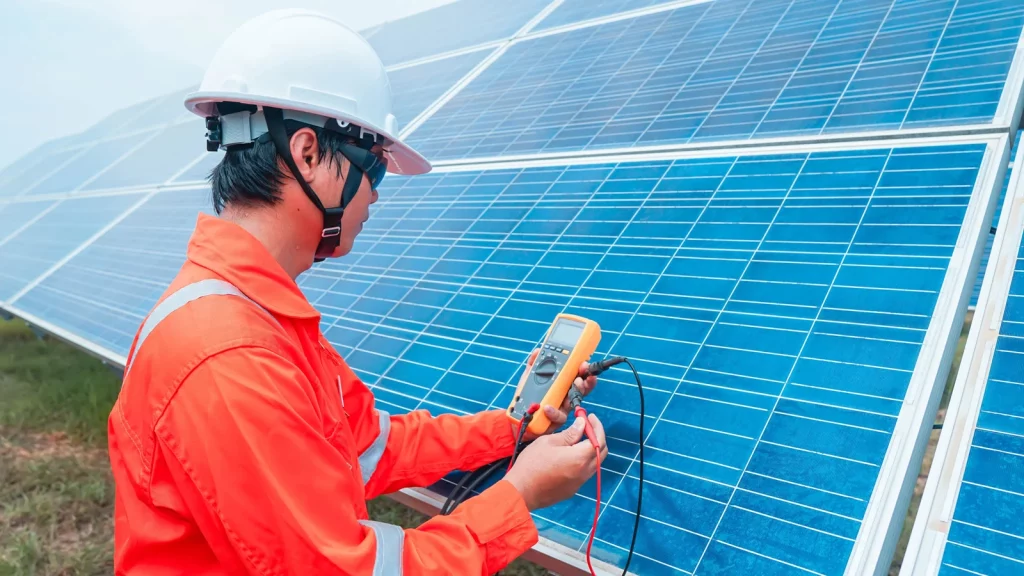Help Center
A Day in the Life of a Solar O&M Engineer
Solar installations are increasing all over the world as solar energy has gained major acceptance as a sustainable and clean power source. According to the International Energy Agency (IEA), by 2050, renewable energy sources like those from photovoltaic cell (PV) facilities will make up 11% of the global energy demand. However, solar photovoltaic (PV) systems need constant upkeep and supervision to operate effectively and consistently. Engineers who specialize in solar operations and maintenance (O&M) are useful in this situation. We’ll look into the duties and everyday activities of a Solar O&M Engineer in this article, highlighting the critical part they play in ensuring the best performance of solar systems.
Solar O&M Engineer Responsibilities
Morning Routine
A typical day for a Solar O&M Engineer frequently starts early as they want to take advantage of daylight hours for system inspections and maintenance duties. The following may be part of their morning routine:
1. Site Arrival and Safety Checks
The engineer performs safety tests to ensure a secure working environment when they arrive at the solar installation. They study the safety protocols, evaluate any possible risks, and make the required modifications to guarantee safety compliance.

2. Data Monitoring and Analysis
The engineer checks the data from the monitoring systems from the previous day before beginning physical inspections. They examine energy output, weather patterns, and any irregularities or performance deviations from expectations. Potential problems are identified by this study.

3. Visual Inspections
A visual inspection is a useful technique for determining the causes of PV module failures as well as seeing potential problems in the future. This inspection’s goal is to stop flaws that are immediately apparent and might endanger the long-term performance and safety of the solar module. Solar O&M Engineers examine the inverters, racking systems, solar panels, and other parts. They search for physical damage, frayed wires, or a buildup of debris that might impair system functionality. Any problems detected are recorded for further action.
Midday Tasks
The engineer keeps at their responsibilities throughout the day to make sure the solar system runs smoothly:
1. Electrical Checks
The effects of a reduction in the power output of up to 20% from a solar panel can be felt very quickly 3. Ignoring it or just accepting it might cause more deterioration and make the issue worse, eventually rendering the panel practically worthless. Regular electric checks can reduce the negative impact. Electrical tests are carried out by solar O&M engineers to ensure that junction boxes, connections, and wires are in good working order. To find any electrical issues, they monitor voltage, current, and resistance using sophisticated equipment.

2. Cleaning and Maintenance
According to research, the efficiency of solar panels dropped from 1% to 5% due to the accumulation of dust. Another research examined three distinct soiling scenarios and discovered an average decrease of roughly 1%. However, people have reported variations of between 10% and 20% 4. In order to remove dirt, dust, or other debris that might lower energy output, the engineer may arrange cleaning of the solar panels, if necessary. Additionally, they could carry out standard maintenance procedures like tightening bolts or lubricating moving components in tracking systems.

3. Troubleshooting and Repairs
The engineer investigates the system to determine the source of any equipment problems or performance problems. Inverters may need to be reprogrammed, damaged components replaced, or communication problems with monitoring systems may need to be resolved. The market for solar repairs and maintenance will grow as annual global installations are projected to reach 135 GW between 2022 and 2025 5.
Afternoon and Documentation
Typically, administrative work and documentation take up the later hours of the day:
1. Performance Reports
Using the data gathered from the day’s inspections and data analysis, the engineer creates performance reports. They use this to find patterns or potential areas for development by comparing current performance to previous data and benchmarks. The major parameters for the solar performance report are 6: Grid availability (GA), Plant availability (PA), Yield, PR (performance ratio), IPR (investment Performance ratio), WPR – Weather Performance Ratio, OPR – Operating Performance Ratio.
2. Inventory Management
For speedy repairs when they’re needed, inventory management of spare parts and tools is crucial. Engineers keep an eye on stock levels and may arrange replacement part orders as needed.
3. Client Communication
The engineers at Solar O&M keep in touch with customers or facility owners on a regular basis. They discuss suggestions for enhancements or optimizations, identify any problems, and offer updates on system performance.
End of Day and Ongoing Learning
As the day comes to an end, the engineer completes their tasks:
1. Preventive Maintenance Planning
Future maintenance tasks, such as routine inspections and preventative maintenance programs, are planned by engineers. The lifespan of the solar system is increased while downtime is reduced due to these measures.
2. Continuing Education
It’s essential to keep up with the most recent advancements in solar technology, safety laws, and best practices. To advance their skills and expertise, O&M Engineers frequently take part in continuous training and professional development.
In general, a Solar O&M Engineer performs a variety of duties requiring technical proficiency, a commitment to safety, and precise documentation. Physical inspections, data analysis, problem-solving, and customer interactions all play a part in their everyday tasks. These engineers play a crucial part in the continuous development and sustainability of solar energy by assuring the dependable and effective functioning of solar projects.